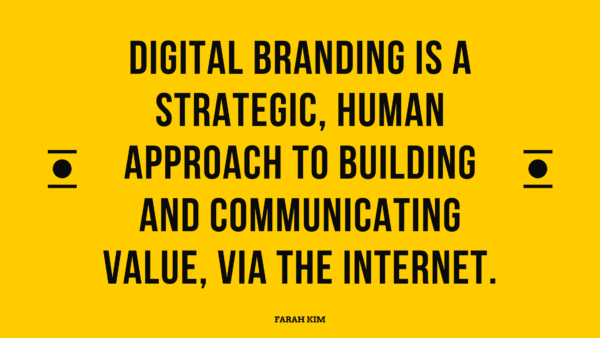Quick question:
What do you understand by the term, ‘digital branding?’
Over the course of my decade-long experience, I’ve received some interesting responses to this question.
Some say:
- It’s a trend.
- It’s a fancy website and logo.
- It’s advertising.
- It’s image building.
Others say:
- It’s what consumers think about their business.
- It’s what they think about their business.
- It’s their business persona.
…..and so on. While interesting, none of these responses truly define what digital branding is.
Why should you care?
Because digital branding is a small business’s best bet to stay competitive in a dynamic business landscape.
What Is Digital Branding – The Definition You Won’t Find on the Internet.
99Design defines digital branding as, ‘how you design and build your brand online through websites, apps, social media, video and more.’
ContentRefined defines it as, ‘a term that’s used rather loosely to describe all the different ways in which a business draws in its customers online.’
WebsiteProfs, being a web design company, defines branding, as, ‘It’s a well-planned & professionally
developed web presence that reflects your business vision & mission.’
These are actually good definitions of digital branding, but they talk of tools and ways, instead of the activity itself.
But my experience with small businesses across industries & countries tells me that digital branding is more than just logos, websites, apps or social media.
“Digital branding is a strategic, human approach to building and communicating value, via the Internet.”
Now to achieve this goal, you can make use of websites, logos, social media, apps, anything the Internet has to offer.
In a nutshell, digital branding is a strategy. It’s a plan that incorporates intent, messaging, customer journeys, insights, content direction, and much more. This plan is then executed with the help of tools and platforms.
Why Does All This Matter?
Because business dynamics have changed. Your audience is now tech-savvy. They make key purchase decisions only after they are satisfied with what they see about you online.
For example, when a visitor lands on your website, what they see and read influences their perception of your business.
If they see generic, meaningless headlines, they’ll leave. If they don’t understand your messaging, they won’t trust you. If your website isn’t user-friendly, they’ll leave as quickly as they landed.
Digital branding, therefore, is more than just a logo, a website, or a video. It’s an experience.
How to Get Started with Digital Branding? A 5-Step Approach
1. Create a Differentiation Strategy
I stumbled upon, ‘differentiation strategy,’ while reading up some of Peep Laja’s addictive content. It was in a long time that I had read something so powerful, so real, in the digital marketing space.
A differentiation strategy is a way to stand out from the noise and give people a reason to choose your business over others. – Peep Laja.
Personally, I believe digital branding starts with a differentiation strategy, especially if you’re in a saturated industry. The fact that you have to find a way to stand out from the noise creates the perfect opportunity to craft your digital branding approach.
P.S – While the differentiation strategy sounds great, you might want to tread carefully. If you don’t have the resources, team, abilities, and skills to go through every minor detail of your business, you might not be able to implement any of the given strategies in the article.
2. Focus on Sales Copy and Brand Messaging
People often mistake digital branding for digital assets. Truth is, the copy on your website, the content you post on your blog and social media is your branding. It’s your voice. It sets your audience’s expectations. Sadly, 8/10 businesses get their content wrong.
Here’s some hilariously horrible copy. 8 BAD COPYWRITING EXAMPLES
Brand messaging is often overlooked because it requires time, thought, and lots of testing. For small businesses, brand messaging is the strongest value builder. You’re literally asking your audience to trust you enough to buy from you without knowing you, meeting, or interacting with your business. To say that words are powerful is perhaps an understatement.
3. Define a Brand Personality with the Right Visuals
This is a classic mistake I’ve seen almost every small business owner make. They’ll hire a web developer for cheap, who’ll probably be using a theme to deploy the website. The owner will either write the content themselves or again hire someone else for cheap to write the content. Then, they’ll hire someone else to do the logo design. Later down the line, someone else to do the social media who’ll probably be using Canva (nothing against Canva, I love it!) to create branded posts.
What’s the one problem with this approach? There’s no uniformity in terms of style and aesthetics. The outcome is a weird website that looks bad and performs badly. It’s better to hire an agency that can give you a one-stop solution so you can get consistency with your brand personality.
4. Create a Consistent Customer Journey
You’ve probably heard influencers and marketers talk about customer journeys – a lllooot. But they always associate this with some funnel in the marketing plan. I like to associate the customer journey with digital branding.
If I don’t know what my customers want, what are their preferred channels of communication, or the kind of experience they demand from my business, how am I supposed to develop my brand?
Customer journeys, customer experiences, customer touch-points should all be part of your master plan. Whether you’re an e-commerce store or a cafe, you need to build your branding strategy based on your customer journey.
5. Now Connect Your Copy, Designs, Experiences
Uniformity across the board. A strategy built on customer experiences, insights, or journeys. A design built on business values, missions, and vision. A strategy brand messaging. All of this combined is digital branding and this connection will help you stand out from the rest.

A Quick Summary
- Create a differentiation strategy
- Work on brand messaging and sales copy
- Ensure brand personality and voice consistency
- Ensure uniformity across platforms and channels
- Maintain connectivity across different touchpoints
In a competitive business landscape that’s largely digital, you can’t afford to be lax with your branding. The future is human-centric branding. Get it right and thrive.
Business & Finance Articles on Business 2 Community
(77)








